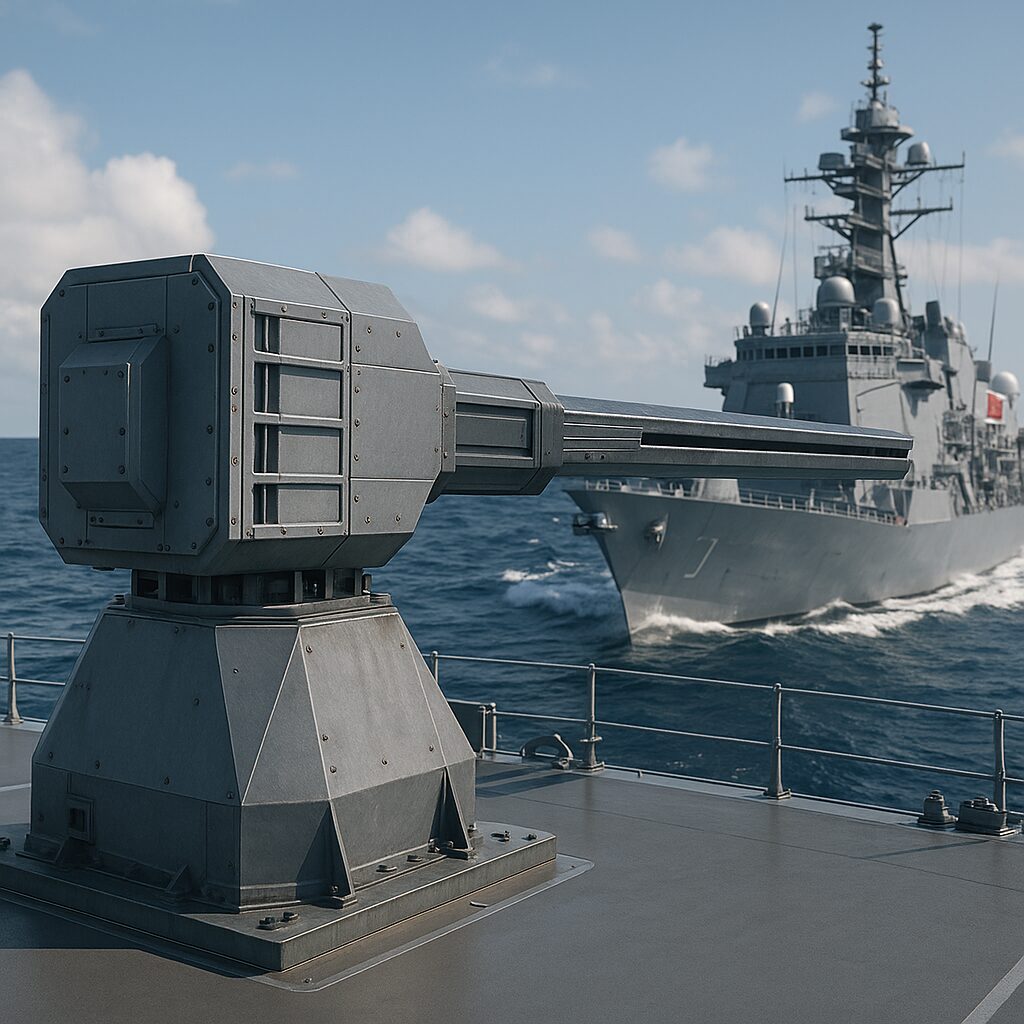Japanese Railgun

Japanese Railgun
🇯🇵Technology, Development, and Future Prospects of Japanese Railgun
Japan, known for its technological innovation in fields like robotics and high-speed rail, is now attracting global attention for a completely different kind of high-speed technology — the electromagnetic railgun. This cutting-edge weapon system could redefine naval warfare in the near future. In this article, we’ll explore what a railgun is, Japan’s involvement in its development, its potential uses, and what the future might hold.
⚙️ What Is a Railgun?
A railgun is a type of weapon that uses electromagnetic force — rather than chemical explosives — to launch projectiles at extremely high speeds. It consists of two conductive rails and a sliding armature. When a powerful electric current is passed through the rails and the armature, it creates a magnetic field that propels the projectile at hypersonic speeds (Mach 6+), sometimes over 2,000 meters per second.
🚀 Key Features:
- No explosive propellants
- Extremely high velocity
- Potential for long-range, low-cost per shot
- Minimal heat signature compared to traditional guns
- Safer ammunition storage on board military vessels
🔬 Japan’s Railgun Project: Overview
Japan’s railgun program is led by the Acquisition, Technology & Logistics Agency (ATLA) under the Ministry of Defense. Although railgun research has been dominated by the U.S. and China, Japan has made significant strides in recent years, particularly in response to regional threats such as North Korea’s missile program.
Japan’s approach focuses on a compact, scalable model that can be deployed on multiple platforms, including both naval vessels and mobile land-based units. This adaptability makes the Japanese railgun program especially unique.
🧪 Timeline:
- 2016: ATLA began research into electromagnetic railgun systems.
- 2022: Japan revealed a functional prototype that could fire projectiles at 2,300 m/s.
- 2023–2024: Testing began on warships and land-based platforms.
- 2025 and beyond: Potential integration with the Japan Maritime Self-Defense Force (JMSDF).
- Future plans: Collaboration with Japan’s space and tech sectors for dual-use applications
🛡️ Why Is Japan Developing a Railgun?
Japan’s strategic priorities center on defense and deterrence. With increasing missile threats from neighboring countries, Japan is exploring railguns as a potential interception tool — capable of destroying incoming hypersonic or ballistic missiles in flight.
Railguns also offer a major tactical advantage in scenarios where traditional missile defense systems might be too slow, costly, or easily overwhelmed by saturation attacks.
🎯 Intended Use Cases:
- Anti-missile defense: A fast and accurate response system.
- Naval warfare: Mounted on destroyers to counter air and sea threats.
- Cost-effective deterrence: Railgun rounds are significantly cheaper than missile interceptors like the SM-3.
- Satellite protection: Potential future use to defend space assets from low-orbit threats
🧰 Technical Challenges
Railguns require massive amounts of electricity and durable materials that can withstand extreme heat and stress. Japan’s engineers are working to overcome key hurdles:
- ⚡ Power Supply: Compact and reliable power systems for deployment on ships
- 🧱 Barrel durability: Materials that can handle rapid firing without degrading
- 🎯 Precision: Targeting systems for high-speed interception of fast-moving threats
- 🔄 Heat management: Advanced cooling systems for sustained use during battle conditions
Despite these challenges, Japan’s progress has been steady and carefully calculated. The country’s strong background in robotics, electronics, and high-energy systems gives it a distinct advantage in solving these problems.
🌐 How Does Japan Compare to Other Nations?
| Country | Railgun Status | Notable Achievements |
|---|---|---|
| Japan | Testing prototype | Mobile testing on JMSDF vessels |
| USA | Development halted | Major progress, but paused in 2021 |
| China | Sea testing phase | Possible deployment near Taiwan |
| Russia | Research phase | Few public updates |
Japan is one of the few countries actively testing railguns in real environments, giving it a potential edge in rapid deployment. Unlike the U.S., which paused its program due to cost concerns, Japan has focused on developing a more modular and cost-effective solution.
🔮 The Future of Railguns in Japan
The Japanese railgun program is still in its testing phase, but it holds promise. If successful, railguns could be a key part of Japan’s next-generation defense systems, integrated alongside laser weapons and missile interceptors in a multi-layered security strategy.
Japan’s Ministry of Defense has indicated interest in pairing railguns with unmanned vessels and AI-driven surveillance drones to create a fully networked defense system.
📅 What’s Next?
- Mid-2020s: Expanded testing on Aegis-equipped destroyers
- 2030s: Possible operational deployment
- Integration with AI: For autonomous targeting and real-time defense coordination
- Public-private partnerships: Collaboration with companies like Mitsubishi Electric and Toshiba for applied research
💬 Final Thoughts
Japan’s railgun project exemplifies how cutting-edge technology can be adapted for defensive purposes in a complex geopolitical environment. While railguns may not yet be battlefield-ready, Japan’s proactive development and testing place it among the world leaders in this emerging domain.
The balance between innovation, strategic need, and economic feasibility seems to be guiding Japan’s development path — and it may become a model for other nations seeking to modernize their own defense technologies.
As Japan continues to innovate in electromagnetic weaponry, its railgun might just become the next-generation shield guarding the nation’s seas and skies.
🔗 Bonus Trivia:
Did you know Japan’s interest in electromagnetic launchers goes beyond weapons? The same principles are also being explored for future maglev space launch systems, possibly enabling small satellites to be launched without rockets!










